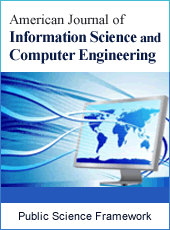American Journal of Information Science and Computer Engineering
Articles Information
American Journal of Information Science and Computer Engineering, Vol.2, No.4, Jul. 2016, Pub. Date: Jul. 21, 2016
H-crystal as a Core Structure in Multilayer Weighted Networks
Pages: 29-44 Views: 4411 Downloads: 1225
[01]
Simon S. Li, School of Information Management, Nanjing University, Nanjing, China; Jiangsu Key Laboratory of Data Engineering and Knowledge Service, Nanjing, China.
[02]
Xia Lin, College of Computing and Informatics, Drexel University, Philadelphia, USA.
[03]
Xiaozhong Liu, School of Informatics and Computing, Indiana University, Bloomington, USA.
[04]
Fred Y. Ye, School of Information Management, Nanjing University, Nanjing, China; Jiangsu Key Laboratory of Data Engineering and Knowledge Service, Nanjing, China.
Extending the network h-core in single layer weighted networks, a method to extract a multilayer weighted network’s core structure, called h-crystal, has been proposed and verified. By applying the algorithms of h-degree and h-strength to each individual layer, a network’s h-core consisting of all the nodes having the h-degree above within edges and an h-subnet consisting of all the edges having the h-strength above with the nodes adjacent to the edges had been obtained, for each layer, at first. H-crystal is then identified by constructing layer-bridges between the layers’ network h-cores and h-subnets. Via two empirical cases of information networks, it is found that the h-crystals of the networks exist, while their features and properties are revealed.
H-degree, H-strength, Network H-core, H-subnet, H-crystal, Multilayer Networks, Weighted Network, Information Network, Heterogeneous Network
[01]
D. J. Watts, S. H. Strogatz, Collective dynamics of 'small-world' networks, Nature, 393(6684), 440-442(1998).
[02]
A.- L. Barabási, R. Albert, Emergence of scaling in random networks, Science, 286(5439), 509-512(1999).
[03]
R. Albert, A.-L. Barabási, Statistical mechanics of complex networks, Review of Modern Physics, 74(1): 47–97(2002).
[04]
A. Barrat, M. Barthélemy, R. Pastor-Satorras, and A. Vespignani, The architecture of complex weighted networks, Proceedings of the National Academy of Sciences of the USA, 101(11), 2747-3752 (2004).
[05]
K. Börner, S. Sanyal, and A. Vespignani, Network science, Annual Review of Information Science and Technology, 41, 537-607(2007).
[06]
M. E. J. Newman, “Networks: An Introduction”, Oxford: Oxford University Press (2010).
[07]
A. Clauset, C. Moore, and M. E. J. Newman, Hierarchical structure and the prediction of missing links in networks, Nature, 453, 98-101(2008).
[08]
M. A. Serrano, M. Boguñáb, and A. Vespignani, Extracting the multiscale backbone of complex weighted networks, Proceedings of the National Academy of Sciences of the USA, 106(16), 6483-6488(2009).
[09]
Y.-Y. Ahn, J. P. Bagrow and S. Lehmann, Link communities reveal multiscale complexity in networks, Nature, 466, 761-765(2010).
[10]
M. E. J. Newman, The structure and function of complex networks, SIAM Review, 45(2): 167-256(2003).
[11]
M. De Domenico, A. Sole´-Ribalta, E. Cozzo, et al., Mathematical Formulation of Multilayer Networks, Physical Review X, 3(4), 041022(2013).
[12]
S. Boccaletti, G. Bianconi, R. Criado, C.I. del Genio, J. Gómez-Gardeñesi, M. Romance, I. Sendiña-Nadal, Z. Wang and M. Zanin, The structure and dynamics of multilayer networks, Physics Reports, 544, 1-122(2014).
[13]
G. Bianconi, Statistical mechanics of multiplex networks: entropy and overlap, Physical Review E, 87, 062806(2013).
[14]
F. Battiston, V. Nicosia, and V. Latora, Structural measures for multiplex networks, Physical Review E, 89, 032804(2014).
[15]
G. Menichetti, D. Remondini, P. Panzarasa, R. J. Mondragon and G. Bianconi. Weighted Multiplex Networks, Plos One, 9(6), e97857(2014).
[16]
E. Yan, Y. Ding, Measuring scholarly impact in heterogeneous networks, Proceedings of the American Society for Information Science and Technology, 47(1), 1-7(2010).
[17]
E. Yan, Y. Ding, C. R. Sugimoto, P-Rank: An indicator measuring prestige in heterogeneous scholarly networks, Journal of the American Society for Information Science and Technology, 62(3), 467–477(2011).
[18]
X. Liu, C. Guo, Y. Yu and Y. Sun, Meta-Path-Based Ranking with Pseudo Relevance Feedback on Heterogeneous Graph for Citation Recommendation, Proceedings of the ACM International Conference on Information and Knowledge Management, 121-130(2014).
[19]
X. Liu, Y. Yu, C. Guo, Y. Sun and L. Gao, Full-Text based Context-Rich Heterogeneous Network Mining Approach for Citation Recommendation, Proceedings of the ACM/IEEE Joint Conference on Digital Libraries, 361-370(2014).
[20]
Y. Sun, J. Han, “Mining heterogeneous information networks: principles and methodologies”, Morgan & Claypool Publishers (2012).
[21]
J. E. Hirsch, An index to quantify an individual’s scientific research output, Proceedings of the National Academy of Sciences of the USA, 102(46), 6569-16572(2005).
[22]
A. Schubert, A. Korn, A. Telcs, Hirsch-type indices for characterizing networks, Scientometrics, 78(2), 375-382(2009).
[23]
S. X. Zhao, R. Rousseau, F. Y. Ye, h-Degree as a basic measure in weighted networks, Journal of Informetrics, 5(4), 668-677(2011).
[24]
S. X. Zhao, F. Y. Ye, Exploring the directed h-degree in directed weighted networks, Journal of Informetrics, 6(4), 619-630(2012).
[25]
S. X. Zhao, P. L. Zhang, J. Li, A. M. Tan and F. Y. Ye, Abstracting Core Subnet of Weighted Networks Based on Link Strengths, Journal of the Association for Information Science and Technology, 65(5), 984-994 (2014).
[26]
W. Glänzel, The role of core documents in bibliometric network analysis and their relation with h-type indices, Scientometrics, 93(1), 113-123(2012).
[27]
W. Glänzel, B. Thijs, Using ‘core documents’ for the representation of clusters and topics, Scientometrics, 88(1), 297-309(2011).
[28]
W. Glänzel, B. Thijs, Using ‘core documents’ for detecting and labelling new emerging topics, Scientometrics, 91(2), 399-416(2012).
[29]
E. Otte, R. Rousseau, Social network analysis: a powerful strategy, also for the information sciences, Journal of Information Science, 28(6), 441-453(2002).
[30]
S. Boccaletti, V. Latora, Y. Morenod, M. Chavez and D.-U. Hwang, Complex networks: Structure and dynamics, Physics Reports, 424, 175-308(2006).
[31]
S. B. Seidman, Network structure and minimum degree, Social networks, 5(3), 269-287(1983).

ISSN Print: 2381-7488
ISSN Online: 2381-7496
Current Issue:
Vol. 7, Issue 3, September Submit a Manuscript Join Editorial Board Join Reviewer Team
ISSN Online: 2381-7496
Current Issue:
Vol. 7, Issue 3, September Submit a Manuscript Join Editorial Board Join Reviewer Team
| About This Journal |
| All Issues |
| Open Access |
| Indexing |
| Payment Information |
| Author Guidelines |
| Review Process |
| Publication Ethics |
| Editorial Board |
| Peer Reviewers |


